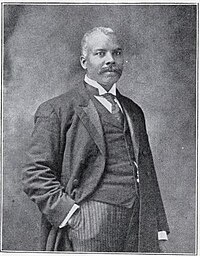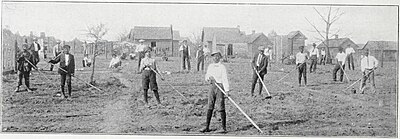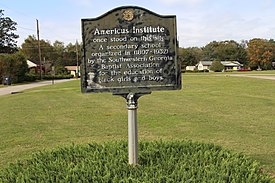Americus Institute
| Americus Institute | |
|---|---|
Coeducational | |
| Language | English |
Americus Institute was a
Establishment and early years

The idea for a
- To provide a thorough high-school education for Negro youth.
- To develop a spirit of self-support in Negro education.
- To stimulate friendly relationship between the races.
Major W. Reddick, a graduate from
In the years following its establishment, the school grew steadily.
Office of Education report

In 1917, the school was covered in a report published by the
Later years

By 1921, the school, with an enrollment of 229 students,[17] was receiving funding from the General Education Board.[18] Additional funding from this time came from the school's 153 acres (62 ha) farm, which generated a net profit of $1,387 in 1922.[4] While the school continued to promote a curriculum of practice over theory, many students from Americus matriculated to some of the best historically black colleges and universities in the country.[4] By 1929, the school became one of five secondary schools to become affiliated with Morehouse College (the new name of Atlanta Baptist College).[19] The school filed for bankruptcy in 1930[20] and permanently closed in 1932.[2] The city purchased the property in 1934 to build a new African American high school.[21]
A
Notes
- ^ Also referred to as the "Southwestern Georgia Baptist Association".[2]
- ^ Sources vary on the size of the school at this time, with one source stating a size of roughly 3 acres (1.2 ha)[1] and another stating a size of less than 2 acres (0.81 ha).[4]
- ^ This included both Reddick and an assistant of his.[1]
References
- ^ a b c d e f g h i j Sale 1907, p. 190.
- ^ a b c d New Georgia Encyclopedia.
- ^ a b c Sale 1907, p. 191.
- ^ a b c d e f g h Southern Workman 1923, p. 509.
- ^ Sale 1907, p. 189.
- ^ a b Hartshorn & Penniman 1910, p. 122.
- ^ Southern Workman 1923, p. 510.
- ^ Sale 1907, pp. 190–191.
- ^ Sale 1907, p. 192.
- ^ Hartshorn & Penniman 1910, p. 370.
- ^ Anderson 2016.
- ^ Hartshorn & Penniman 1910, p. 132.
- ^ Hartshorn & Penniman 1910, p. 74.
- ^ United States Office of Education 1917, p. 243.
- ^ United States Office of Education 1917, p. 241.
- ^ a b c United States Office of Education 1917, p. 242.
- ^ Negro Year Book 1922, p. 278.
- ^ Negro Year Book 1922, p. 260.
- ^ Brackney 2008, p. 182.
- ^ Butler Herald 1930, p. 22.
- ^ The Atlanta Constitution 1934, p. 12.
- ^ Jones 2020.
Sources
- Anderson, Alan (November 21, 2016) [July 18, 2003]. "Americus". New Georgia Encyclopedia. Archived from the original on February 26, 2022. Retrieved March 1, 2022.
- "New Negro School". Newspapers.com.
- ISBN 978-0-88146-130-5.
- "State News Summary". Butler Herald. Butler, Georgia. December 11, 1930. p. 22.
- Hartshorn, W. N.; Penniman, George W., eds. (1910). An Era of Progress and Promise, 1863–1910: The Religious, Moral, and Educational Development of the American Negro since his Emancipation. Boston: The Priscilla Publishing Company.
- Jones, Alex (February 17, 2020). "Black History Trolley Tour gives you a glimpse of African-American history in Americus". WTVM. Archived from the original on March 1, 2022. Retrieved March 1, 2022.
- McCarthur, Georgia (February 16, 2020). "African-American tour explores Americus' historic past". WALB. Archived from the original on February 29, 2020. Retrieved March 1, 2022.
- Negro Year Book: An Annual Encyclopedia of the Negro, 1921–1922. Tuskegee, Alabama: Negro Year Book Publishing Company. 1922.
- "Americus Institute". New Georgia Encyclopedia. Image from Michael Rivera. Archived from the original on March 1, 2022. Retrieved March 1, 2022.
{{cite web}}: CS1 maint: others (link) - Sale, George (May 1907). "Americus Institute". The Baptist Home Mission Monthly. XXIX (5). American Baptist Home Mission Society: 189–192.
- "Americus Institute". Hampton Normal and Agricultural Institute: 508–510. October 1923.
- Negro Education: A Study of the Private and Higher Schools for Colored People in the United States. Vol. II. )
External links
 Media related to Americus Institute at Wikimedia Commons
Media related to Americus Institute at Wikimedia Commons
